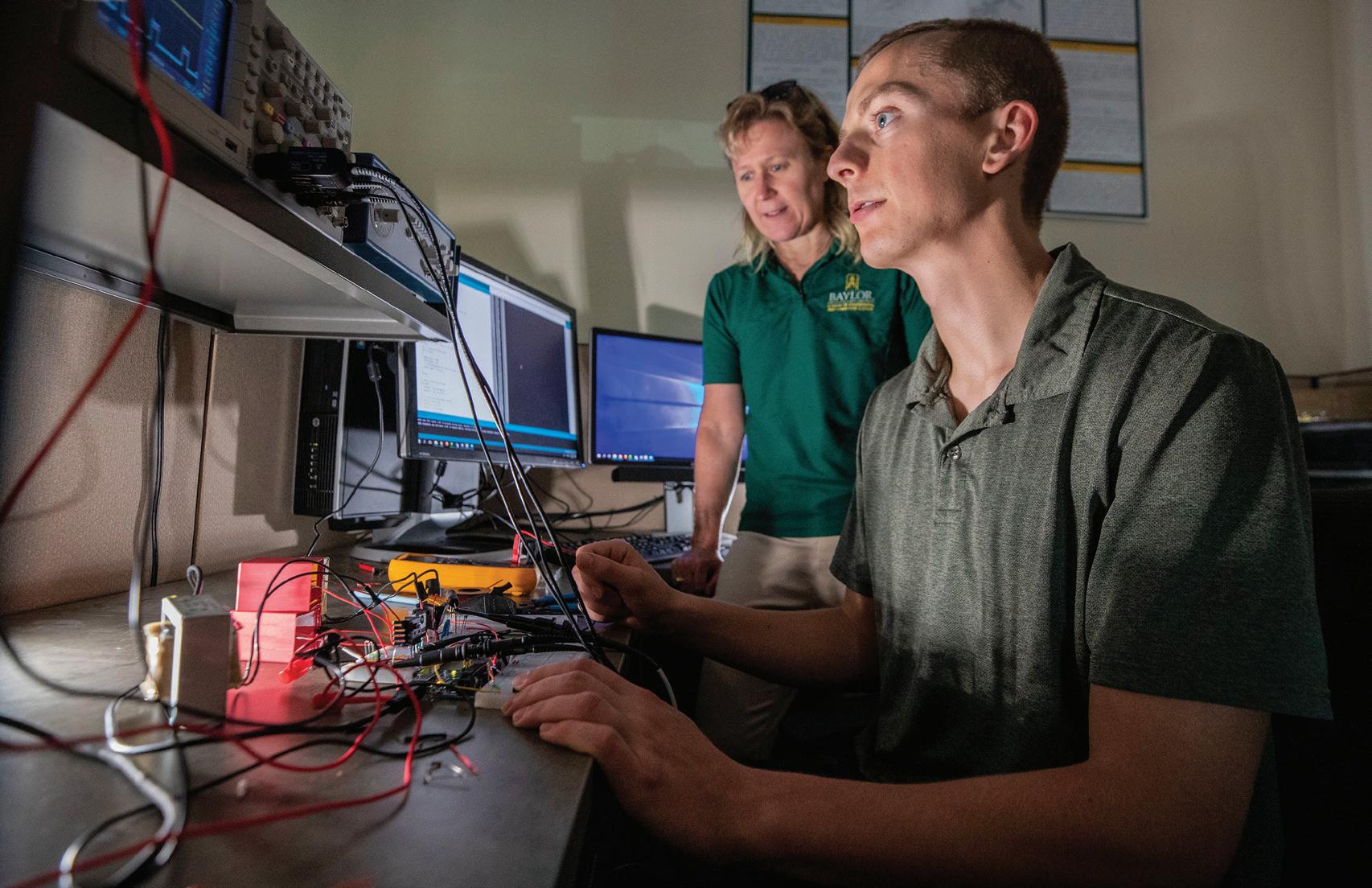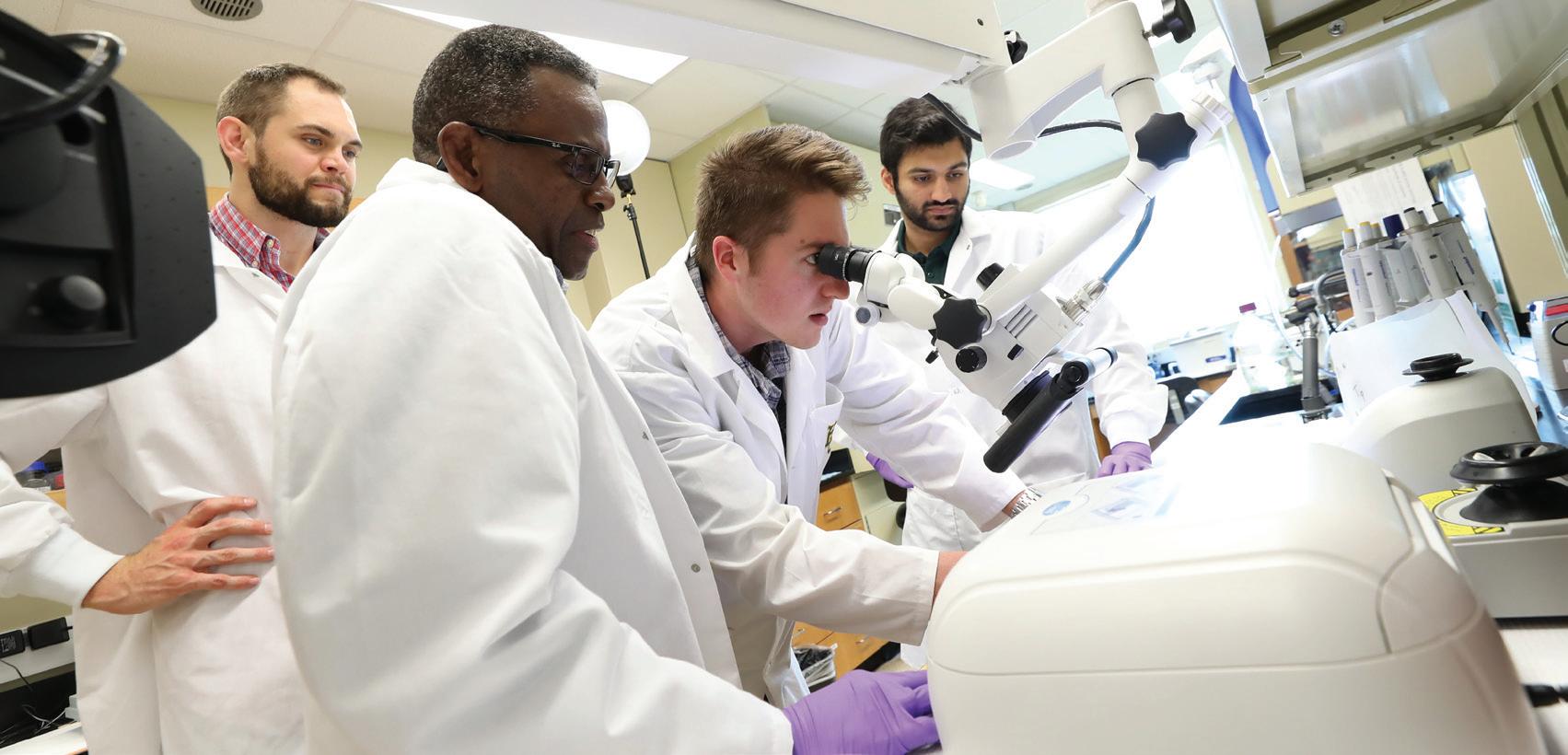
7 minute read
R1: A Multiplier Effect for Central Texas
by Derek Smith, Assistant Director of Research Communications, Baylor Marketing & Communications
When Baylor was recognized as an R1 research institution in December 2021, it represented the attainment of a long-pursued goal: to join the nation’s elite research institutions in the top tier of national research universities.
This achievement was meaningful not only for Baylor University, but for the Greater Waco community and Central Texas. R1 recognition serves not only as an endorsement of the success of Baylor’s efforts to reach these heights, but sets the stage for where Baylor is headed— further impact.
Baylor is one of only 146 universities recognized by the Carnegie Classification of Institutions of Higher Education as having “very high research activity.” Such universities, only 39 of which are private institutions, earn the R1 designation by meeting an elite combination of metrics related to research dollars earned and spent, research staff hired and more.
“This is a tremendous accomplishment for so many reasons,” Baylor University President Linda A. Livingstone, Ph.D., said. “Through top-tier research, scholarship and external funding support, R1 universities bring their voice to bear in addressing our world’s most significant challenges…And that gives us a lot of credibility. It attracts students and benefits them when they’re going out and looking for jobs. A Baylor degree is more valuable. It’s also incredibly valuable as we hire top faculty, who want to be at an R1 institution.”

A Cutting-Edge Community
From academic buildings in the heart of campus to facilities in the community like the Baylor Research and Innovative Collaborative (BRIC), the impact of R1 can be felt in a number of avenues of community benefit—a multiplier effect that develops when an institution is invested in pursuing new discoveries and greater knowledge.
Tangible aspects of that cutting-edge commitment include: research and technology development that spurs external grant funding, the creation of new companies formed by that research, high-level partnerships with national agencies and recruitment of top students and faculty. Already, Baylor’s investment in research has yielded:
The successful recruitment of six nationally renowned faculty, hired from other elite institutions into newly endowed chairs, with more than 20 additional hires planned. These faculty hires bring students, infrastructure and industry and federal partnerships from other institutions to the Baylor and Waco community;
Partnerships with the U.S. Department of Defense, NASA, Harvard University and more—each serving to bring high-level projects that result in local spending to Waco; and
The awarding of 113 patents and formation of four new companies created through Baylor tech commercialization efforts, each creating new job opportunities for both students and professionals.
“Nothing succeeds like success,” Vice Provost for Research Kevin Chambliss, Ph.D., said. “Our faculty have pursued and won highly-competitive research grants. We’ve built resources to facilitate growth, and we’ve invested in attracting top faculty and research partners. Now that we’ve achieved R1 status, we can build on that foundation. People want to be a part of what we’re doing here, and we’re seeing that generate community benefit.”

Faculty Recruitment: A Competitive Edge
Top faculty naturally want to work at the top research universities—institutions with the infrastructure to support their work. Not unlike a top coach in college athletics, talented individuals look for places that give them a great chance to win. Baylor’s pursuit and attainment of R1, combined with purposeful investment in those positions, is paying dividends. The University is delivering on plans to create and hire more than 20 endowed faculty chairs, as well as 100 net new faculty over a five year period–bringing an influx of talent to Waco. Thanks to the generosity of Baylor donors and institutional investment, those positions are funded far beyond salary costs. Endowed chair positions provide sustained funding that make them particularly appealing to established researchers. Among the positions already filled are:
Julia Chan, the Tim and Sharalynn Fenn Family Endowed Chair in Materials Science, who comes to Baylor from LSU and UT-Dallas;
Craig Gundersen, the Jim and Tammy Snee Family Chair in Food Security, who comes from the University of Illinois;
Henry Han, the McCollum Family Chair in Data Sciences, whose most recent post was at Fordham University;
Brian Jordon, the Kenneth and Celia Carlile Endowed Chair in Materials Science, who joins Baylor from the University of Alabama;
Alan Wang , the Mearse Chair in Biological and Biomedical Engineering, who comes from Oregon State University; and
Aaron Wright , the Schofield Endowed Chair in Biomedical Science, whose most recent post was at Pacific Northwest National Laboratories.
Combined, these faculty deliver not only decades of experience in fields like data science, quantum materials, engineering and metals, but bring their own talented research teams and meaningful partnerships. Dr. Jordon, for instance, brings to Baylor significant partnerships with NASA, the Department of Defense, and Department of Energy, along with an entire research lab of students from Alabama. Through his recruitment, that vitality comes to Central Texas.
Not limited to new hires, however, R1 recognition elevates the work of longtime faculty who have helped Baylor reach that status, opening doors for additional research partnerships and student recruitment.



The BRIC: Fostering a High-Tech Community
A fall 2021 report released by the National Academy of Inventors and Intellectual Property Owners
Association included Baylor amongst the Top 100 Worldwide Universities Granted U.S. Utility Patents that year. This recognition highlighted success within Baylor’s Technology Commercialization and Industry Engagement (TCIE) efforts, which includes the Lab to Market Collaborative (L2M). TCIE and L2M partner with Baylor faculty whose research shows promise for real-world products, helping them navigate funding, intellectual property rights protection, prototyping and more.
Since 2020, four companies have launched through L2M generating over $15 million in research funding.
Those companies include:
6P Color, Inc. , an imaging system to revolutionize color displays on high-definition screens for television, telephones, digital display screens and more;
Athule Aero, which develops ultra-quiet and energy efficient propellers, with the potential to reduce propeller noise on aircraft by 50-75%;
Chariot Innovations, LLC , which built a product called the MiraColt to deliver the benefits of therapeutic horseback riding to individuals without access to horses, including children with autism; and
Verifi Technologies , which advances ultrasound technology to test airplane parts without destroying advanced materials, making safety-testing more cost-effective and less time-consuming.
These companies are housed in the Baylor Research and Innovation Collaborative (BRIC), a 330,000-square-foot facility with state-of-the-art research laboratories, bays and offices. The BRIC has proved a competitive advantage in the University’s efforts to attract faculty in STEM fields, helping form new research partnerships in addition to new companies.

Baylor students, likewise, benefit from a real-world approach to technology development and research at the BRIC. Students who work in BRIC labs have gone on to top industry jobs through the experience they gain. Additionally, commercialization of that research through company formation can help many remain in Waco and draw outside organizations to Waco more regularly to partner with faculty and students, supporting efforts to build a vibrant STEM workforce in Central Texas.
“Not A Finish Line”
With Baylor’s recognition as an R1 institution, many have asked what’s next for the University. R1 is a significant achievement, but not an end goal. Research marked by quality, visibility and impact remains at the forefront of Baylor’s future goals—and there is no finish line for those pursuits. The University will continue systemic investment in new positions, programs and facilities – building on R1’s multiplier effect in ways that elevate the research enterprise and attract people, programs, partnerships and external investment in the community.
“R1 is a meaningful achievement, but it is not the finish line,” President Livingstone said. “It is a meaningful marker on our pathway to preeminence as a Christian research university. Stronger academics and high-quality research attract high-quality faculty and students, further helping us to have meaningful influence, visibility and impact on the world, because we believe the world needs a Baylor.”






